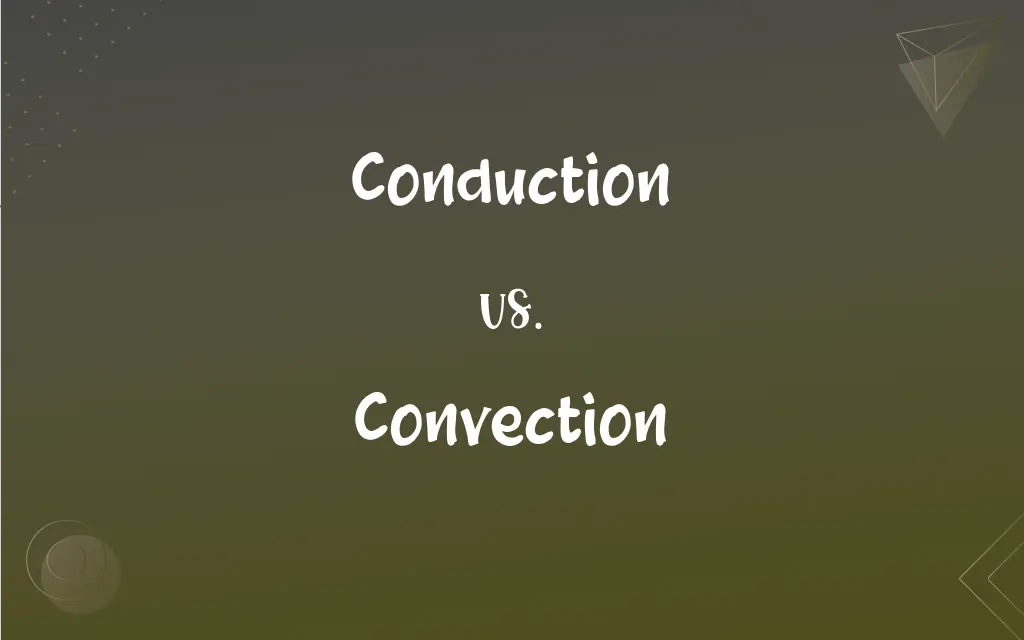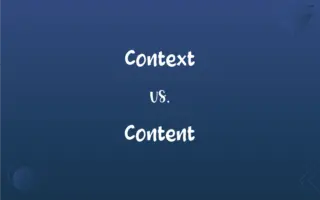Conduction vs. Convection: What's the Difference?
Edited by Aimie Carlson || By Harlon Moss || Updated on October 27, 2023
Conduction is heat transfer through direct contact; convection involves heat transfer through fluid movement.

Key Differences
Conduction and convection are two modes of heat transfer. Conduction occurs when heat moves through a material without the material itself moving. It relies on direct contact between particles, with energy being passed from one to another. Metals are good conductors because their particles are closely packed and can easily transfer energy.
Convection, on the other hand, involves the movement of a fluid (liquid or gas) carrying heat with it. It's driven by the tendency of warmer, less dense fluid to rise and cooler, denser fluid to sink, creating a flow. This can be seen in the boiling of water, where hot water rises and cooler water descends.
While conduction is a transfer of heat through direct contact, convection requires the physical movement of the fluid. In conduction, heat spreads through solids, whereas convection mainly occurs in fluids. Both are fundamental in understanding how heat moves in various environments.
In many real-world scenarios, conduction and convection work together. For example, in a heated room, conduction warms the walls, and convection distributes this heat through air circulation. Understanding the difference helps in designing efficient heating systems or managing heat in electronic devices.
While conduction is more effective in materials with tightly bound particles, convection is the primary form of heat transfer in fluids. The efficiency of conduction and convection depends on the properties of the material or fluid involved.
ADVERTISEMENT
Comparison Chart
Medium
Occurs in solids, liquids, and gases
Mainly occurs in fluids (liquids and gases)
Movement
No physical movement of the material
Involves the movement of the fluid
Contact
Direct contact between particles
Transfer through fluid circulation
Efficiency
Efficient in dense materials
Efficient in fluids, influenced by fluid flow
Example
Heat moving through a metal rod
Heat circulating in boiling water
ADVERTISEMENT
Conduction and Convection Definitions
Conduction
The process by which sound waves travel through a medium.
The conduction of sound through water is faster than through air.
Convection
Circulatory motion that occurs in fluids due to temperature and density variations.
Convection causes hot air to rise and cool air to sink in the atmosphere.
Conduction
Transfer of heat through direct contact between materials.
The handle of a metal spoon gets hot due to conduction when left in a pot of boiling soup.
Convection
The transfer of heat by the mass motion of a fluid.
The Earth's mantle experiences convection, influencing plate tectonics.
Conduction
Electricity transmission through a conductor.
Copper wires facilitate the conduction of electricity to power homes.
Convection
The process of fluid circulation due to differences in density.
Convection currents in the ocean regulate global climate patterns.
Conduction
Heat transfer within a material without bulk motion of the material.
In a brick oven, conduction evenly cooks the pizza crust.
Convection
Movement of heat in a fluid due to the motion of the heated particles.
The convection of heat from a radiator warms up a room.
Conduction
The transfer of nerve impulses between neurons.
Conduction of nerve signals enables the body to react to stimuli.
Convection
Heat transfer through the movement of a fluid.
The convection of air inside an oven ensures even baking.
Conduction
The transmission or conveying of something through a medium or passage, especially the transmission of electric charge or heat through a conducting medium without perceptible motion of the medium itself.
Convection
The act or process of conveying; transmission.
FAQs
What is convection?
The transfer of heat through the movement of fluids (liquids or gases).
Is conduction faster in metals or non-metals?
Faster in metals due to closely packed particles.
Where does convection occur?
Mainly in fluids.
What is conduction?
The transfer of heat through direct contact between materials.
Where does conduction occur?
In solids, liquids, and gases.
Does convection require fluid movement?
Yes, it involves the physical movement of the fluid.
How does conduction affect cooking in a pan?
Heat is conducted from the pan to the food directly.
Does conduction require material movement?
No, it happens without the physical movement of the material.
Is conduction responsible for heat transfer in space?
No, space is mostly vacuum; radiation is responsible there.
Can conduction and convection occur simultaneously?
Yes, they often occur together in many natural and artificial processes.
Can convection occur in a vacuum?
No, as it requires a fluid medium.
What influences the efficiency of convection?
Fluid properties and flow dynamics.
How does convection contribute to weather patterns?
Convection currents in the atmosphere affect weather and climate.
What's a common example of conduction in everyday life?
Feeling the warmth of a hot cup of coffee through the cup.
What's a common example of convection in everyday life?
Feeling the warmth from a heating vent as warm air circulates in a room.
What influences the efficiency of conduction?
Material density and particle proximity.
Are liquids generally better conductors or convectors?
Better convectors due to their ability to flow.
Do convection ovens use the principle of convection?
Yes, they circulate hot air for even cooking.
Are convection currents present in boiling water?
Yes, they cause the hot water to rise and cool water to sink.
Can conduction occur in a vacuum?
No, since it requires particles to transfer heat.
About Author
Written by
Harlon MossHarlon is a seasoned quality moderator and accomplished content writer for Difference Wiki. An alumnus of the prestigious University of California, he earned his degree in Computer Science. Leveraging his academic background, Harlon brings a meticulous and informed perspective to his work, ensuring content accuracy and excellence.
Edited by
Aimie CarlsonAimie Carlson, holding a master's degree in English literature, is a fervent English language enthusiast. She lends her writing talents to Difference Wiki, a prominent website that specializes in comparisons, offering readers insightful analyses that both captivate and inform.































































